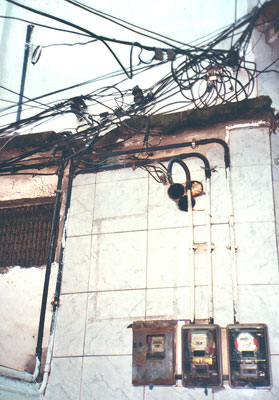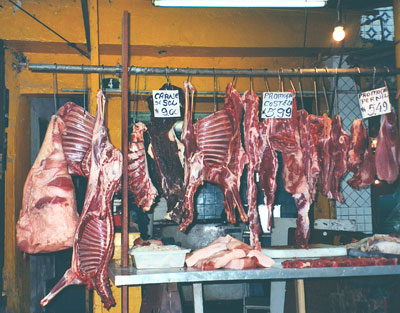A look inside the ‘favelas’ of Rio de Janeiro
by Sibyl James, Seattle, WA
Rio de Janeiro is synonymous with Carnaval, tiny thong bathing suits, “The Girl from Ipanema” and “Cristo Redentor,” the giant statue of Christ that overlooks its beaches from a nearby hill. For tourists, Rio’s favelas (slums) are not normally part of the agenda. They were part of mine.
Dispelling stereotypes
Braving a conversation on the hotel phone with my mix of Spanish and English (in a Portuguese-speaking country), I made an appointment for a favela tour with the man my Lonely Planet guidebook identified as a favela resident. When he failed to show, I resorted to Favela Tour, the agency described in a brochure I found at my hotel.
In the end, it seemed only simple justice, since Marcelo Armstrong, the man behind the agency, was the one who instigated such tours, which he began as a way to counteract the media’s portrayal of Brazil’s favelas — a crusade he undertook 15 years before my August ’07 visit.
Based on the media’s portrayal, I had expected shacks of cardboard and corrugated tin, mounds of garbage, a communal porta-potty here and there and a central water pump, the sort of scene I’d encountered in the movies and, to some degree, in a visit to South Africa’s Soweto.
Instead, I found 2-story concrete homes mixed with shops — much like the low- and middle-income neighborhoods I’d seen (and lived in) in Africa and Latin America — not communities carrying the stigma of crime and drugs that I’d been led to associate with the word “favela.”
Living in the favela
These homes extended inward into labyrinthine narrow alleys of stairs that led past more and more layers of small apartments. It was reminiscent of a rabbit warren or a scene from “Alice in Wonderland.”
There was sometimes a darkness in which a tiny stream flowed or an apartment that was rendered windowless, and other times there was the welcoming brightness of walls painted in primary colors and decorated with mosaics made from tiles left over from the construction of homes. All of it was swept clean.
You might be thinking that this was a “model” favela, and, indeed, the first one we visited was part of a project funded by the Inter-American Development Bank and the city government to improve the infrastructure of such neighborhoods. While most favelas do have plumbing, here the system was better.
And though the tangle of wires would enrage a US fire marshal, the setup was legal, with each home connected to its own electric meter (while in some favelas people tend to wire in illegally). Among the tangles were connections for DSL and cable.
Rio businesses have enticingly lenient installment payment plans for electronics. One apartment we saw featured only some bedding on the floor and an enormous television. Everybody has their own priorities.
We emerged from the labyrinths to the homes of the rich just across the street, where many of the favela dwellers work as maids or gardeners. In Rio, the rich are always shoulder to shoulder with the poor. But, given the fact that the favelas climb the city’s hills, ironically the poor have the best views. It’s my guess, however, that the view doesn’t compensate for the lack of transportation up those steep hills.
In the largest favela, home to over 60,000 people, there is only one main street and three side streets. Garbage has to be carried down those streets to designated spots where city workers deign to collect it. Buses will carry you to favela stops, but you’re on your own to negotiate the climb home.
Rough reality
Are the rich worried about the proximity of favelas? Probably so, as evidenced by the security fences around their homes, but the guide told us that the gangs who run the favelas also protect the nearby rich neighbors — part of their scheme to not draw the police into the favela. As a result, there’s little crime in the favelas or nearby, we were told.
Our Lonely Planet guidebook put it more starkly: part of the reason for the “mellowing” of favelas is the presence of “the drug traffickers, whose deadly style of community policing serves as a brutal but effective deterrent.” So, although Marcelo Armstrong’s tours do contradict the image of favelas as crime-ridden, that security seems to be a double-edged sword.
In Rio, there are three primary gangs whose business, besides functioning as the local police, is drugs, gathered from other Latin American countries and sold in the US, Europe and cities like Rio. But in the favelas themselves, the addiction problem is alcohol, not drugs.
“Don’t take photos on this street,” the guide cautioned as we wandered into Rocinha, the largest of Rio’s favelas — big enough to have its own cable TV channel, major bus station and newspaper. At the end of the street sat masses of motorcyclists who functioned as “taxis,” drug runners and the “eyes” of the gang for the neighborhood. The boys on the motorcycles looked like teenagers anywhere, not a pack of Hell’s Angels, and the street bustled with people shopping.
Without the guide’s warning, I would probably have snapped a panoramic neighborhood shot. Instead, I aimed my camera at the feathered bodies of chickens trussed up for sale in a sidewalk stall.
New understanding
Our tour ended with a visit with local artisans, who were selling their wares at a spot with a view of Rio’s landmarks: “Christ the Redeemer” and Sugarloaf Mountain. There were purses made from the pull-tabs of beer and soda cans, landscapes fashioned from bits of carpet, and innumerable paintings of the favelas themselves.
I purchased a scene of homes, first painted and then embroidered by the old women of the community. Since I’m just over 60 myself, I felt a particular affinity with the maker of this scene.
Despite our tour’s focus on more solid neighborhoods, there are also favelas of tar paper-and-tin shacks, like the ones I saw while traveling into the city from the airport. But that’s only the first step. As soon as possible people turn to concrete, which is more difficult for the authorities to remove. If they manage to squat there for five years, they own their home.
In Rio, there are currently 750 favelas, housing nearly 20% of the city’s population. Such settlements now have turned into established neighborhoods that have their own samba schools and feature prominently in Brazil’s Carnaval.
While the tour had seriously revised, though not completely dispelled, the preconception I had of favelas, it had humanized that image, increasing my understanding of the difficulties faced by the residents as well as my respect for their methods of coping.
Maybe the biggest surprise was the way the neighborhoods received our tour group. I had expected to feel like a voyeur of poverty, inspiring embarrassment, even hostility, in the residents. Instead, life there went on as normal — just what you’d expect in any neighborhood.
Tours in English, French, Spanish and Italian can be booked through Favela Tours (phone 055 21 3322 2727, www.favelatour.com.br). Two 3-hour tours are offered each day, beginning at 9 a.m. and 2 p.m., with transportation by minivan between sites. The tour cost is approximately $45.




